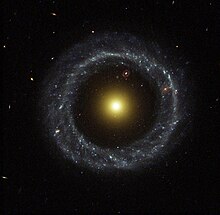Prstencová galaxie
Prstencová galaxie je typ galaxie s kruhovým vzhledem. Prstenec obsahuje mnoho relativně mladých modrých hvězd, které jsou masivní a velmi jasné; v centrální oblasti se pak oproti tomu nalézá relativně málo svítivá hmota. Příkladem takového typu galaxie je Hoagův objekt, objevený Artem Hoagem v roce 1950.
Podle některých astronomů, např. Appletona a Struck-Marcella z Iowa State University, se prstencové galaxie tvoří průchodem menší galaxie středem galaxie větší.[1] Protože většina objemu galaxií je jen prázdný prostor, tato „kolize“ málokdy vede k jakýmkoli skutečným kolizím mezi hvězdami. Nicméně gravitační poruchy způsobené takovou událostí by mohly způsobit vlnu tvorby hvězd napříč větší galaxií.
Podle jiných teorií[kdo?] vznikají prstencové galaxie kolem některých galaxií pomocí vnější akrece. Kvůli otřesům a kompresi akreovaného materiálu by pak v této prstencové oblasti docházelo ke zvýšené tvorbě hvězd.
Odkazy
Reference
V tomto článku byl použit překlad textu z článku Ring galaxy na anglické Wikipedii.
- ↑ APPLETON, P.N.; STRUCK-MARCELL, Curtis. Collisional Ring Galaxies. Fundamentals of Cosmic Physics. 1996, čís. 16, s. 111–220. Dostupné online. (anglicky)
Související články
- Interagující galaxie
- Kolo od vozu
Externí odkazy
 Obrázky, zvuky či videa k tématu Prstencová galaxie na Wikimedia Commons
Obrázky, zvuky či videa k tématu Prstencová galaxie na Wikimedia Commons - Hoagův objekt, Astronomický snímek dne na stránkách České astronomické společnosti
Média použitá na této stránce
A nearly perfect ring of hot, blue stars pinwheels about the yellow nucleus of an unusual ring galaxy known as Hoag's Object. This image from NASA's Hubble Space Telescope captures a face-on view of the galaxy's ring of stars, revealing more detail than any existing photo of this object. The image may help astronomers unravel clues on how such strange objects form.
The entire galaxy is about 120,000 light-years wide, which is slightly larger than our Milky Way Galaxy. The blue ring, which is dominated by clusters of young, massive stars, contrasts sharply with the yellow nucleus of mostly older stars. What appears to be a "gap" separating the two stellar populations may actually contain some star clusters that are almost too faint to see. Curiously, an object that bears an uncanny resemblance to Hoag's Object can be seen in the gap at the one o'clock position. The object is probably a background ring galaxy.
Ring-shaped galaxies can form in several different ways. One possible scenario is through a collision with another galaxy. Sometimes the second galaxy speeds through the first, leaving a "splash" of star formation. But in Hoag's Object there is no sign of the second galaxy, which leads to the suspicion that the blue ring of stars may be the shredded remains of a galaxy that passed nearby. Some astronomers estimate that the encounter occurred about 2 to 3 billion years ago.
This unusual galaxy was discovered in 1950 by astronomer Art Hoag. Hoag thought the smoke-ring-like object resembled a planetary nebula, the glowing remains of a Sun-like star. But he quickly discounted that possibility, suggesting that the mysterious object was most likely a galaxy. Observations in the 1970s confirmed this prediction, though many of the details of Hoag's galaxy remain a mystery.
The galaxy is 600 million light-years away in the constellation Serpens. The Wide Field and Planetary Camera 2 took this image on July 9, 2001.
